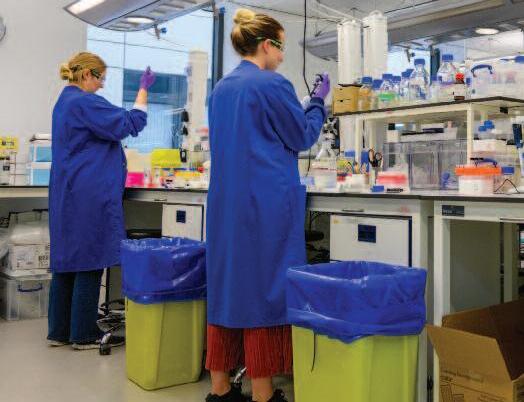
5 minute read
Case Study Delivery of new and repurposed drugs for visceral leishmaniasis and transfer of revolutionary screening platforms to industry
There are estimated to be 600 million people at risk of visceral leishmaniasis (VL) across the globe with 50,000 to 90,000 new cases every year, mainly among the poorest of the poor The disease is caused by Leishmania parasites and is spread through the bite of infected sandflies Limited therapeutic options make the treatment of this neglected disease very challenging Each drug currently in use has serious drawbacks, such as difficulty in administration, length of treatment, toxicity, cost, and emerging drug resistance For example, miltefosine is the only oral drug, but is contraindicated in women of childbearing age as it can cause birth defects
In 2010, the global not-for-profit Drugs for Neglected Diseases initiative (DNDi) reported ‘rediscovery’ of the abandoned drug fexinidazole for the treatment of Trypanosoma brucei (causing African sleeping sickness), a parasite related to Leishmania
Advertisement
The drug was thought to require activation by an enzyme in the parasite Despite the prevailing consensus at DNDi that fexinidazole was inactive against Leishmania, the Dundee team identified that Leishmania had a gene for a similar activating enzyme In 2011, Prof Alan Fairlamb and Dr Susan Wyllie in collaboration with Prof Kevin Read and the University of Dundee Drug Discovery Unit (DDU) undertook a project to examine the efficacy of fexinidazole against Leishmania donovani This culminated in 2012 with the demonstration that fexinidazole displayed excellent parasite killing activity in vivo1 with activity dependent on oral administration and fexinidazole transformation in the liver into its active metabolites The work was reported pre-publication to DNDi and in 2013 they instigated a Phase II proof-of-concept clinical trial for the treatment of adults with VL in East Africa. In parallel, given the paucity of front-line treatments for VL, the DDU in 2011 initiated a major research programme to uncover new drugs for this disease, including developing novel assay platforms to revolutionise leishmaniasis drug discovery 2, 3 A ‘Mode of Action’ research team was also established to discover the molecular targets of drug candidates that were at an advanced stage of development.4, 6 Success of the programme is evidenced by the discovery and development of two clinical drug candidates for VL, each with different mechanisms of action The first candidate arose from a compound series previously discovered in
Dundee that inhibited growth of the related Trypanosoma brucei. Through clever iterative changes to the chemical core scaffold, the Dundee team were able to produce a compound active against the Leishmania parasite The work, published in 2018, also identified the target of the compound as cyclin-dependent related kinase 12 (CRK12), providing Pharma with a completely novel validated drug target for Leishmania 4 Discovery of the second clinical drug candidate also began with compounds discovered in Dundee to be active against a different related parasite, Trypanosoma cruzi, which causes Chagas disease Repurposing and optimisation in Dundee 5, 6 produced a compound with potent activity against Leishmania that was shown to act through inhibition of the proteasome.6
An important impact of Dundee’s research has been adoption by industry of a suite of screening and assay platforms developed by the DDU for VL drug discovery These were transferred to GSK (following training of GSK staff in Dundee) and are now widely used by industry and Product Development Partnerships In total, DNDi and GSK have screened >500,000 and 1 8 million compounds respectively using DDU assays, a feat previously impossible with earlier, laborious assays. The Mode of Action group screening cascades also provided DNDi, GlaxoSmithKline and others with knowledge that saved resources by enabling decisions not to proceed with compounds that might have negative outcomes. Overall, the DDU’s drug discovery expertise has enhanced the productivity of the global VL drug discovery portfolio DNDi comment on DDU’s gold standard screening assays thus:
Dr Charles Mowbary, Discovery Director, DNDi.
References
1 The Anti-Trypanosome Drug Fexinidazole Shows Potential for Treating Visceral Leishmaniasis Wyllie, S, Patterson, S, Stojanovski, L, Simeons, FRC, Norval, S, Kime, R, Read, KD & Fairlamb, AH (2012), Science Translational Medicine, vol 4, no 119, pp119re1
2 Comparison of a high- throughput high-content intracellular Leishmania donovani assay with an axenic amastigote assay De Rycker, M, Hallyburton, I, Thomas, J, Campbell, L, Wyllie, S, Joshi, D, Cameron, S, Gilbert, IH, Wyatt, PG, Frearson, JA, Fairlamb, AH & Gray, DW (2013), Antimicrobial Agents and Chemotherapy, vol 57, no 7, pp 2913-2922
3 Development and validation of a novel Leishmania donovani screening cascade for high-throughput screening using a novel axenic assay with high predictivity of Leishmanicidal intracellular activity. Nühs, A, De Rycker, M, Manthri, S, Comer, E, Scherer, CA, Schreiber, SL, Ioset, J-R & Gray, DW (2015), PLoS Neglected Tropical Diseases, vol 9, no 9, e0004094
4 Cyclin-dependent kinase 12 is a drug target for visceral leishmaniasis Wyllie, S, Thomas, M, Patterson, S, et al (2018), Nature, vol 560, no 7717, pp 192-197
5 'Identification of GSK3186899/DDD853651 as a Preclinical Development Candidate for the Treatment of Visceral Leishmaniasis Thomas, MG, De Rycker, M, Ajakane, M, et al (2019), Journal of Medicinal Chemistry, vol 62, no 3, pp 1180-1202
6 Preclinical candidate for the treatment of visceral leishmaniasis that acts through proteasome inhibition Wyllie, S, Brand, S, Thomas, M, De Rycker, M et al (2019), Proceedings of the National Academy of Sciences, vol 116, no 19, 201820175, pp 9318-9323










